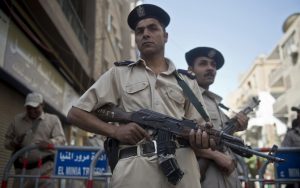In a devastating blow to Egypt’s counter insurgency efforts, 54 members of the security forces were reported killed during a security operation in the Farafra Oasis on 21 October. This oasis located a mere 135 km south-west of Cairo, like reported by opendemocracy.net.
The exact number of those killed remains unknown. The interior ministry issued an official statement claiming that only 16 police offers had been killed, whereas security officials initially stated that 59 had been killed. The Egyptian government criticized international media for inflating the number of causalities.
At first the government held the Hassm group responsible; a group it claims is the armed wing of the Muslim Brotherhood – even though the Brotherhood has denied the claims. It remains unclear until now who is responsible for the ambush; no concrete evidence of Hassm responsibility has been provided – even though a fabricated claim has been circulating – and more recently a new group Ansar El-Islam, who are allegedly connected to Al Qaeda, have claimed responsibility.
A deeper analysis of this recent security blunder reveals both operational as well as political failures in handling an increasingly deadly insurgency which has claimed the lives of hundreds of members of the security forces.
According to Mostafa Bakry, a pro-regime parliamentarian, a security operation was initiated from a tip off that an insurgent cell was hiding in the Western Desert. However, when security forces went to this location, the insurgents had prior warning and ambushed the security forces, causing heavy causalities.
The insurgents’ ability to counter the security forces and obtain advance knowledge of their movement raises the specter of security leaks and the infiltration of the security apparatus.
Ahmed Mansour, the ex-head of the police academy, claimed that “treason” was an integral part of this security blunder. It is not the first time that the Egyptian security apparatus has been subjected to infiltration; the most infamous example was that of Wilayat Sinai when they managed to bypass security and plant a bomb inside a Russian chartered aircraft in October 2015 killing all 224 passengers.
On the operational side, there are a number of signs of systematic failures. For example, one of the reasons cited by the authorities for the abysmal performance of the security forces is the lack of air support and proper reconnaissance before the operation. The commanding officer was unable to call for reinforcement due to poor telecommunications.
This was compounded by the insurgent’s intimate knowledge of the terrain, a lack of investment in topographical training and rudimentary counter-insurgency equipment – such as, satellite based equipment that is essential in operations in remote parts of the country – and poor recruitment practices.
The strategy of the Egyptian government has been to heavily invest in the purchase of traditional heavy weaponry, such as the 11.9 billion dollars in 2015, with little investment in equipment that is better suited for conducting counter insurgency operations.
The location of the operation also highlights the Egyptian government’s counter-insurgency strategy failure. For unlike the insurgency in Sinai, which is far from the political and economic center of the country, this operation was a mere 135 KM from the capital.
If there is a new group that is capable of delivering such a painful blow to the security forces so close to the capital, then there are higher chances of sophisticated terror operations taking place in the capital.
On the political level the regime reacted in an atypical manner, which is an indication of the size of the blunder as well as the weakening of the appeal of the “war on terror” rhetoric.
Unlike on other occasions when these incidents were exploited, this time the regime attempted to create a façade of normalcy with President Sisi participating the following day in celebrations for the anniversary of the battle of El Alamein, not making any public announcements about the ambush.
In terms of government controlled media, the level of reporting was rather slim, as the regime attempted to suppress and control the narrative. Interestingly, Ahmed Moussa, a talk show host and one of the most ardent supporters of the regime had his show suspended after having reported casualty figures that contradicted those of the government in addition to having conducted interviews with some of the survivors in which harrowing tales of the assault were relayed that exposed the ineptness of the security forces.
The Egyptian regime has systematically failed to counter the deadly insurgency that has been growing in the country. There is a lack of preparedness and investment in countering the insurgency and the wave of repression has not lead to an improved security situation, on the contrary, Cairo is now more of a target to insurgents.
One of the most notable examples of suppression of independent voices was the arrest of Ismail El Iskandarani, an independent researcher who was one of the first to highlight the role Hisham Ashmawi, an ex-special forces officer, was playing in the evolving insurgency in Sinai. Iskandarani was also critical of the ineffective counter-insurgency strategy of the military.
It seems that this security blunder and the repeated failure of the regime in tackling the insurgency is becoming a source of embarrassment. This is a regime that has been justifying its campaign of mass repression with security threats and the fight against terror. The regime will no longer be able to use the “war on terror” rhetoric as a tool to solicit popular support for its repressive policies.
Unless there are deep reforms, one can only expect that the insurgency will become more deadly.



